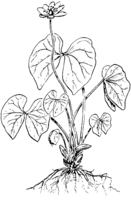 | Back to e-WV
| Back to e-WV
 The West Virginia Encyclopedia
The West Virginia Encyclopedia
 | Back to e-WV
| Back to e-WV
 The West Virginia Encyclopedia
The West Virginia Encyclopedia

Early spring in West Virginia, from late February to early April, signals the bonanza of wildflowers soon to come. The first flowers bloom in southern West Virginia, along stream banks. Blooming gradually migrates northward across the state, and upward to the highest peaks of the Alleghenies. Coltsfoot begins to cover roadsides with yellow, as its smaller lookalike cousin, dandelion, covers yards and fields. Dainty pink-striped flowers of spring beauties and the white and blue hepatica are a sure sign that spring is just around the corner. In cold mountain swamps, skunk cabbage produces heat to melt the ice and pushes up its quaint green cap with a purple pedestal inside. The large green leaves will flourish in the warm spring rains. Sharp eyes will spot the fragrant pink and white flowers of trailing arbutus, peeking out from under leaves flattened by winter snows.
The woods become a fascinating kaleidoscope of colors and a paradise of magnificent spring wildflowers as temperatures rise and rain showers fall. The 27 species of violets vary from white and yellow to blue. Phlox flowers range from white and blue to pink and red. White flowers of Clintonia, plumelily, anemones, mayapple, twinleaf, bloodroot, squirrel corn, Dutchman’s breeches, toothworts, stonecrop, foamflower, sweet cicely, and saxifrage seem to dominate. Mayapple is recognized by the large white flower and unique umbrella-like leaves. The low-growing stonecrop has three spikes of flowers and succulent leaves similar to cactus. Dutchman’s breeches look like a pair of pants hanging upside down. Its cousin, squirrel corn, has a white flower resembling a boiled kernel of corn and root bulbs that look like yellow corn.
The yellow flowers of buttercups, fawn lilies, bellworts, and golden-knees are common. Marsh marigold, also yellow, is less common and grows in wet areas in the high mountains. The rare yellow lady’s slipper, with its moccasin-shaped flowers, can be found in secret haunts of the deep, rich woods.
The more common pink lady’s slipper (moccasin flower) prefers dry, acid woods. The showy orchis grows in rich, moist woods and has a three-to-six inch spike of delicate white and pink flowers. Shooting star flowers are pure white in southern West Virginia and deep pink elsewhere. The brightest red flower belongs to fire pink, which inhabits dry road banks and cliffs, along with red columbine flowers.
The blue flowers of dwarf iris, dwarf larkspur, wild geranium, Virginia bluebell, and blue-eyed Mary are fairly common.
Fields, meadows, and forest openings furnish habitat for many spring wildflowers. Dandelions, ragworts, and cinquefoils are common yellow flowers. Chickweeds, wild strawberries, and pussytoes are white, while florets are yellowish blue.
Leaves on trees absorb so much sunlight that summer and fall wildflowers forsake the woods for fields, roadsides, openings, and riverbanks. Canada and Turk’s cap lily with large red and yellow recurved petals are two of the showiest summer wildflowers. Pasture and swamp rose flowers are showy pink and extremely fragrant. The orange flowers of butterfly weed attract numerous butterflies and insects, as do all milkweeds. Many legumes, such as wild senna, wild indigo, and partridge pea, flower with bright splashes of yellow. Goat’s rue, with large yellow and purple flowers, is one of the prettiest legumes. Equal to the goat’s rue is the rare wild lupine of our eastern counties, with its spike of bright blue flowers. Poison hemlock and water hemlock are two of several members of the carrot family, with large cup-shaped clusters of white flowers. Numerous mints and bedstraws with white, blue, and yellow flowers are common summer wildflowers.
Autumn, from mid-August through October, is a time of painted landscapes as tall, leafy plants of sunflowers, goldenrods, asters, and phlox provide a spectacle of flowers to match the dazzling array of fall leaf colors. Fall wildflowers generally are tall, with many leaves, and spikes or heads of flowers.
There are 22 species of goldenrods and 17 species of sunflowers that are almost all yellowish. The 30 species of asters have mostly white or blue flowers. New England aster is the showiest, with large deep violet-purple flowers, and sometimes contrasting pink or white flowers as well. Shale barren aster has lighter purple flowers but grows in very dry rocky soils and will bloom profusely until snows begin to fall. Large pink clusters of joe-pye weeds and deep purple clusters of ironweeds add to the variety of autumn colors.
Complementing all of these are the white thoroughworts and boneset, and the fuzzy pink flower heads of thistles and knapweeds. Occasionally the golden yellow foxgloves will lean outward from a road bank, or the tall white multi-spiked Culver’s root will show off its glory in a wet roadside or meadow. Fall phlox and wild sweet William prefer the shady floodplains of larger streams to display their pink flower clusters. The same is true of great blue lobelia and cardinal-flower with its deep scarlet flowers, which also grow in wet road ditches. The deep blue flowers of gentians hide in dense grass and herbs where you must search for them.
We have about 2,600 plants in West Virginia. Of this number, 850 are non-native exotics, more than 100 are trees, 100 are shrubs that have inconspicuous flowers, and about 300 are grasses and sedges whose flowers are seldom noticed. An additional 200 or so herbs have very inconspicuous flowers. That leaves about 1,000 wildflowers prominent enough to be noticed by non-botanists. From cliff to swamp, mountaintop to valley, and deep woods to parking lots, there is a wildflower that grows in every niche. Some are small and hardly noticed, while others are large, bright, showy flowers suitable for the garden of a queen. Wildflowers can bloom during any month of the year, but truly spectacular flower shows occur in April and May and August through September.
Written by William N. Grafton